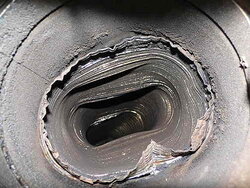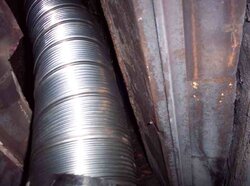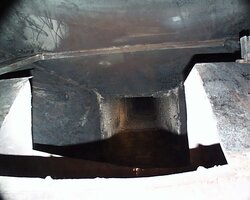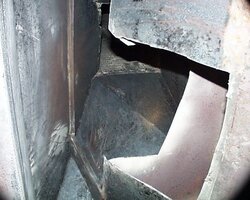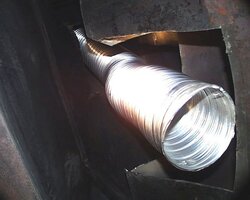okay, maybe this is obvious, but as I consider the hopeful near future of my insert install I got to looking at my fireplace. The throat damper is 6 inches and it seems that this is a common size. When the insert goes in, does that entire iron piece - not just the flap, need to come out or is 6" liner les than 6" or am I going to need to cut into it to make room for the liner? Is this where 5.5 liners come into play?
removing fireplace damper
- Thread starter philaphire
- Start date
-
Active since 1995, Hearth.com is THE place on the internet for free information and advice about wood stoves, pellet stoves and other energy saving equipment.
We strive to provide opinions, articles, discussions and history related to Hearth Products and in a more general sense, energy issues.
We promote the EFFICIENT, RESPONSIBLE, CLEAN and SAFE use of all fuels, whether renewable or fossil.
You are using an out of date browser. It may not display this or other websites correctly.
You should upgrade or use an alternative browser.
You should upgrade or use an alternative browser.
- Status
- Not open for further replies.
ozarkjeep
New Member
- Nov 6, 2006
- 407
I removed my flap, supposedly there is a pin and it will drop out, I cut one end of it, couldnt find the pin ( took 5 minutes with a sawzall)
the liner wouldnt fit, you are right, its 6" or less, and the liner will probably no go thru perfectly 'plumb'
so, I notched a 'V" on either side of the cast iron shelf, right where the liner goes thru.
it gave room to wiggle that liner into place easily, and didnt interfere with the fitup to the top of stove.
the liner is so rigid that its hard to manipulate.
Good luck!
I think ive got some pics at home if that would help you, just let me know.
the liner wouldnt fit, you are right, its 6" or less, and the liner will probably no go thru perfectly 'plumb'
so, I notched a 'V" on either side of the cast iron shelf, right where the liner goes thru.
it gave room to wiggle that liner into place easily, and didnt interfere with the fitup to the top of stove.
the liner is so rigid that its hard to manipulate.
Good luck!
I think ive got some pics at home if that would help you, just let me know.
philaphire said:okay, maybe this is obvious, but as I consider the hopeful near future of my insert install I got to looking at my fireplace. The throat damper is 6 inches and it seems that this is a common size. When the insert goes in, does that entire iron piece - not just the flap, need to come out or is 6" liner les than 6" or am I going to need to cut into it to make room for the liner? Is this where 5.5 liners come into play?
so you got the sawzall out and just made it work huh? how did the saw do on the cast iron shelf? Pics would be great to see what I'm up against - thanks!
Highbeam
Minister of Fire
The installer for my insert completely removed the damper and frame. Sawzall in the middle and then pulled it out. It looked to be mild steel 3/16 to 1/4 inch thick. Removing that baffle made much more room to provide a smooth bend into the stovetop.
jldunn
New Member
They used an electric jack hammer on mine and took the whole metal piece out. It came out pretty easy that way. They needed the jack hammer to widen up the flue opening so they could put the liner through without bending it anyway (not that it seemed like there was much chance of bending that homesaver stuff).
ecfinn
New Member
Mine must've been cast iron b/c my installer took out his agression on my damper with a 5lb hand sledge until pieces started falling out.  Took about 5" minutes though and he was getting winded... Just needed enough room for the liner to clear it.
Took about 5" minutes though and he was getting winded... Just needed enough room for the liner to clear it.
Eric
 Took about 5" minutes though and he was getting winded... Just needed enough room for the liner to clear it.
Took about 5" minutes though and he was getting winded... Just needed enough room for the liner to clear it.Eric
MrGriz
New Member
I removed the plate and was able to slightly ovalize the liner where it passes throuh the damper opening. Seemed easier than removing the entire thing.
Highbeam
Minister of Fire
Not that you would ever want to go back to using your fireplace as a fireplace but I think there is something to be said for leaving the damper frame in place as a sort of reversible modification. I also wonder if some masons don't use the damper assembly to help support the brickwork. At the very least, the damper frame would make a nice place to mount a lower block off plate. Mine is out though.
Rhone
Minister of Fire
- Nov 21, 2005
- 827
My installers removed just the flap, it came out with a pin and then a push to the right or left and out it came. My inspector warned me when I scheduled the inspection that he wants to see the cast iron flap. Don't throw it away, plus if you ever want to get it back to original specs you'll need it.
Usually, removing the flap doesn't leave 6" for the liner and it's often ovalized at the end. You don't want to order an ovalized liner if you can help it, they're extremely expensive, and don't ship well. Do a search on here on how to ovalize a round flex liner. Just a warning, it does hinder your draft. The more you ovalize, the worse your draft and potential to have smoke pour into the house when you open the insert/stove door. My installers purchased 5' of ovalized flex liner and put it at the end of my rigid liner, ovalizing it even more leaving it looking like this. It was ovalized (choked is probably a better word) too much, and they left too many gaps... I had terrible draft, smoke poured into the house on reloads, the smoke detector would go off occasionally, couldn't even think about lighting a fire unless it was 45F or less out and I ended up ripping out my entire liner this summer I was so fed up with it. My liner was nothing but problems. I purchased a new round flex for the end, cut out the damper so it wouldn't need to be ovalized, and purchased an Extend-a-flue to add another 4' to my chimney. Greatest move I ever did! It's simply a joy now! I get no smoke into the house, my glass stays much cleaner, I can light a fire at 55F+ outside and it'll draft fine, I cut my warm-up times in about half, and I seem to be getting more heat out of my fire.
So, just a warning when you ovalize your liner to go through the damper you don't want to overkill on the ovalization, the more it's ovalized the more risk you have of problems. The best thing, is not to ovalize and cut out the damper area so it fits through but, I think in most cases a little ovalization is fine.
Usually, removing the flap doesn't leave 6" for the liner and it's often ovalized at the end. You don't want to order an ovalized liner if you can help it, they're extremely expensive, and don't ship well. Do a search on here on how to ovalize a round flex liner. Just a warning, it does hinder your draft. The more you ovalize, the worse your draft and potential to have smoke pour into the house when you open the insert/stove door. My installers purchased 5' of ovalized flex liner and put it at the end of my rigid liner, ovalizing it even more leaving it looking like this. It was ovalized (choked is probably a better word) too much, and they left too many gaps... I had terrible draft, smoke poured into the house on reloads, the smoke detector would go off occasionally, couldn't even think about lighting a fire unless it was 45F or less out and I ended up ripping out my entire liner this summer I was so fed up with it. My liner was nothing but problems. I purchased a new round flex for the end, cut out the damper so it wouldn't need to be ovalized, and purchased an Extend-a-flue to add another 4' to my chimney. Greatest move I ever did! It's simply a joy now! I get no smoke into the house, my glass stays much cleaner, I can light a fire at 55F+ outside and it'll draft fine, I cut my warm-up times in about half, and I seem to be getting more heat out of my fire.
So, just a warning when you ovalize your liner to go through the damper you don't want to overkill on the ovalization, the more it's ovalized the more risk you have of problems. The best thing, is not to ovalize and cut out the damper area so it fits through but, I think in most cases a little ovalization is fine.
Attachments
so you ovalize the last little bit to make it through the damper, then what, do you use an oval to round adapter to connect it to the stove?
ozarkjeep
New Member
- Nov 6, 2006
- 407
I would not ovalize my liner at all, you reduce the draft and choke it off in that area by doing so.
here is a photo of how I clearanced my damper sides to fit the 6" SS liner.
I scored it with a grinder, started each notch with a sawzall ( or jigsaw) and then it broke off with a large pipe wrench to get leverage on it.
here is a photo of how I clearanced my damper sides to fit the 6" SS liner.
I scored it with a grinder, started each notch with a sawzall ( or jigsaw) and then it broke off with a large pipe wrench to get leverage on it.
Attachments
Hogwildz
Minister of Fire
I cut mine with a sawzaw & an angle grinder. My liner came just about straight down onto the stove outlet.
Heres a few photos.
The flex pipe in the photo is 6" aluminum I bought at Home Peehole to use as a mock up for the real liner. Came in handy when checking for fit & clearance. Was like $6.00.
Heres a few photos.
The flex pipe in the photo is 6" aluminum I bought at Home Peehole to use as a mock up for the real liner. Came in handy when checking for fit & clearance. Was like $6.00.
Attachments
Hogwildz
Minister of Fire
ozarkjeep said:You got grinder skills for a cave dude!
IM not so sure on that dryer vent as a liner though.
just dont get a flu temp over 150 and youll be fine.
Hey, Its so easy...................... even a Neanderthal can do it!
I was not a happy camper in there grinding & cutting away. I the only thing left white on me was my teeth

MrGriz
New Member
I know that ovalizing the liner can interfere with the draft. However, I ovalized mine where it passes throught the damper (then re-rounded it to connect to the colllar) and have absolutely no problems with draft. I have an external masonry chimney that is approximately 23' tall.
ozarkjeep
New Member
- Nov 6, 2006
- 407
yep, NASTY.
I got in the fireplace with a headlamp, and a grinder, and had a freind hold a wet towel over the opening, I also had a wet/dry vac outside with the hose stuck up thru the ash cleanout to suck the dust away, but still a minute or two of cutting at one time was all I could stand, sparks, flying carborundem ( or whatever those disks are made of) nastyness...
BUT, I felt it needed to be done.
a slight oval is ok, I couldnt fit mine with that though, so I got midevil on its heinie.
I got in the fireplace with a headlamp, and a grinder, and had a freind hold a wet towel over the opening, I also had a wet/dry vac outside with the hose stuck up thru the ash cleanout to suck the dust away, but still a minute or two of cutting at one time was all I could stand, sparks, flying carborundem ( or whatever those disks are made of) nastyness...
BUT, I felt it needed to be done.
a slight oval is ok, I couldnt fit mine with that though, so I got midevil on its heinie.
Hogwildz said:ozarkjeep said:You got grinder skills for a cave dude!
IM not so sure on that dryer vent as a liner though.
just dont get a flu temp over 150 and youll be fine.
Hey, Its so easy...................... even a Neanderthal can do it!
I was not a happy camper in there grinding & cutting away. I the only thing left white on me was my teeth
MrGriz said:I know that ovalizing the liner can interfere with the draft. However, I ovalized mine where it passes throught the damper (then re-rounded it to connect to the colllar) and have absolutely no problems with draft. I have an external masonry chimney that is approximately 23' tall.
Mine was ovalized as well, and I'm bordering on too much draft.
Seems to me that as long as the flex isn't creased at all, there should be no difference in cross sectional area, and as a result no real change in the volume of air that it can handle. I'd think that a smooth transition from circular to oval to circular again should have less impact overall than having two 90 degree bends that is so common with freestanding stoves.
Maybe I'm missing something, but I don't see what the problem with ovalizing the liner is, provided there are no creases and the transitions are smooth.
-Hal
Dunadan
New Member
They took my damper out and didn't have enough room for the liner to go through. After getting my permission, out came the heavy duty saber saw, and several ruined blades later the liner fit fine.
Afterwards the installer made sure to tell me I didn't have a fireplace anymore
Afterwards the installer made sure to tell me I didn't have a fireplace anymore

Hogwildz
Minister of Fire
Dunadan said:They took my damper out and didn't have enough room for the liner to go through. After getting my permission, out came the heavy duty saber saw, and several ruined blades later the liner fit fine.
Afterwards the installer made sure to tell me I didn't have a fireplace anymore
Funny you should mention that. My Summit came with 2 metal plates that are supposed to be mounted to the inside of the old fireplace fire box, warning that the fireplace has been modified.
ok, so the options seem to be ovalize or some serious damper demolition. In my original quesiton I mentioned 5.5" liner - how does that affect draft vs. ovalizing? And does the 5.5 even fit?
Dunadan said:After getting my permission, out came the heavy duty saber saw, and several ruined blades later the liner fit fine.
That sounds familiar. I went through three or four new Sawz-All blades and my teeth were damn near vibrated out of my head trying to cut my cast iron damper frame. The net result, a half inch cut. I finally went to the garage and got my plain old hacksaw and fifteen minutes later the frame was outta there. Go figure. The hacksaw cut that stuff like slightly cold butter. So much for fancy power tools.
Gooserider
Mod Emeritus
I believe the codes require that if you modify the fireplace in any way, even just removing the damper flap, certainly if you start cutting on the frame, that you are required to attach permanent warning signs to the firebox saying that it has been modified and not to use it as a fireplace w/o repairs. Makes sense.
From all I've gathered, not having tried it myself, there is a great deal of variation in damper setups, and the best method of dealing with them depends on the exact setup - knowing what others did is mostly useful just in telling what the options are, but not in direct application.
Ovalizing is ok if it's not overdone, but it's better not to if you can avoid it.
The 5.5" liner is mostly for those cases where a 6" just won't fit - 8x8 tiles that weren't lined up properly, excessive bends or mortar blobs, stuff like that. I probably wouldn't consider it a good choice if the only tight spot is the damper frame.
I'm mildly surprised that nobody has tried using a torch to remove some of the metal bits... I know it's over head and hard to get at, but it would seem like a torch would cut the metal out nicely...
Gooserider
From all I've gathered, not having tried it myself, there is a great deal of variation in damper setups, and the best method of dealing with them depends on the exact setup - knowing what others did is mostly useful just in telling what the options are, but not in direct application.
Ovalizing is ok if it's not overdone, but it's better not to if you can avoid it.
The 5.5" liner is mostly for those cases where a 6" just won't fit - 8x8 tiles that weren't lined up properly, excessive bends or mortar blobs, stuff like that. I probably wouldn't consider it a good choice if the only tight spot is the damper frame.
I'm mildly surprised that nobody has tried using a torch to remove some of the metal bits... I know it's over head and hard to get at, but it would seem like a torch would cut the metal out nicely...
Gooserider
E
elkimmeg
Guest
goose I have used a torch but fine a thin metal cutting wheel in a grinder works well. You are correct that a plate should be attached telling furure owner the damper area has been modified
tYou are also correct that teat is a code requirement. Modifications to the damper are allowed if it doesnot effect structualintegrity of the fireplace B fire bricks can not be removed in the fire box.
Be carefull recomending ovalizing the liner as that can void the listing. Also even though the liner has the same cross-sectional area, ovalizing creates resistance to smoke following the round flue colar. where fricttion is increased flow is reduced and cresote builds up there. There is enough friction caused by flex liner ribbing , without the added ovalizing. I would cut the damper before I ovalized more than 1/2".
Some inserts allow the use of 5.5" liners they are the Hamptons and regency's Code is quite explisit in not allowing a reduction of that of the flue colar diameter. It is best you ask your code official if he will allow the reduction to 5.5. After all it is his signature that will be required. Personally I review it per how the situation dictates. I can not advise you to do something not supported by code. Nor can anyone else here.
tYou are also correct that teat is a code requirement. Modifications to the damper are allowed if it doesnot effect structualintegrity of the fireplace B fire bricks can not be removed in the fire box.
Be carefull recomending ovalizing the liner as that can void the listing. Also even though the liner has the same cross-sectional area, ovalizing creates resistance to smoke following the round flue colar. where fricttion is increased flow is reduced and cresote builds up there. There is enough friction caused by flex liner ribbing , without the added ovalizing. I would cut the damper before I ovalized more than 1/2".
Some inserts allow the use of 5.5" liners they are the Hamptons and regency's Code is quite explisit in not allowing a reduction of that of the flue colar diameter. It is best you ask your code official if he will allow the reduction to 5.5. After all it is his signature that will be required. Personally I review it per how the situation dictates. I can not advise you to do something not supported by code. Nor can anyone else here.
Roospike
New Member
I would think a professional stove installer would have a plasma cutter for the damper modifying and also for quick work of the custom block off plate.
When it come to drilling and cutting steel Sloooooooooooooooooooooooow is key ,
you cant cut or drill high speed in steel/cast with out overheating and killing blades and bits. A good cutting oil and easy does it is how ya have to do it.
When it come to drilling and cutting steel Sloooooooooooooooooooooooow is key ,
you cant cut or drill high speed in steel/cast with out overheating and killing blades and bits. A good cutting oil and easy does it is how ya have to do it.
- Status
- Not open for further replies.
Similar threads
- Replies
- 3
- Views
- 369
- Replies
- 5
- Views
- 1K
- Replies
- 1
- Views
- 201
- Replies
- 6
- Views
- 573


